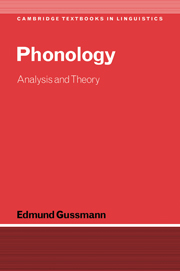Book contents
- Frontmatter
- Contents
- Preface
- List of abbreviations
- 1 Sounds and segments
- 2 The melody and the skeleton
- 3 Domains and phonological regularities
- 4 The syllable
- 5 More on codas
- 6 Some segmental regularities
- 7 Syllable structure and phonological effects: quantity in Icelandic
- 8 Segmental double agents
- 9 Words and feet: stress in Munster Irish
- Conclusion
- Appendix The phonetic alphabet of the International Phonetic Association
- References
- Index
8 - Segmental double agents
Published online by Cambridge University Press: 05 June 2012
- Frontmatter
- Contents
- Preface
- List of abbreviations
- 1 Sounds and segments
- 2 The melody and the skeleton
- 3 Domains and phonological regularities
- 4 The syllable
- 5 More on codas
- 6 Some segmental regularities
- 7 Syllable structure and phonological effects: quantity in Icelandic
- 8 Segmental double agents
- 9 Words and feet: stress in Munster Irish
- Conclusion
- Appendix The phonetic alphabet of the International Phonetic Association
- References
- Index
Summary
Introduction
In several places in the preceding chapters we have indicated that there may be a mismatch between the way a segment is specified as regards its phonological properties and the way it is pronounced. On the one hand we used the notion of the phonetic effect to refer to those aspects of sounds which are not due to any systematic phonological regularities but are in some sense accidental (see 3.5). On the other hand the reverse is also possible, when a segment may be specified for a property which is suppressed as a result of some constraint operative in the language, a case in point being German final devoicing, discussed in 6.7. In the latter case different phonological representations are articulated and perceived as the same physical or phonetic object. Looking at it from a phonetic perspective, this means that the same physical or phonetic object has a double – or perhaps multiple – phonological identity. In the present chapter we would like to take a closer look at such double agents, which are particularly challenging from the point of view of phonological analysis. The double (or multiple) identity of certain segments places upon the analyst the burden of proving their reality. The need to marshal strong and cogent arguments becomes particularly acute. Before considering some more complex cases let us have a look at a relatively simple instance taken from German.
In 6.7 we discussed the issue of German final devoicing and concluded that, in the standard dialect, domain-final empty nuclei do not license the voice property.
- Type
- Chapter
- Information
- PhonologyAnalysis and Theory, pp. 186 - 204Publisher: Cambridge University PressPrint publication year: 2002



